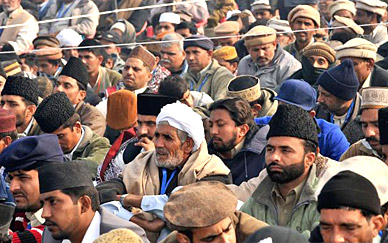 Ahmadiyya sect is one fast growing movements of Islam. Ahmadiyyas are the proselytising Muslims of whom there are ten million spread all over the world today. Mirza Ghulam Ahmad of Qadian, who was the founder of the sect, claimed that Jesus Christ did not ascend to heaven and will not come back to earth as trusted by the Muslims but that he himself was the promised messiah who had come to carry forward the mission of Mohammad in the world. Orthodox mullahs called Ahmadiyyas `heretics`.
Ahmadiyya sect is one fast growing movements of Islam. Ahmadiyyas are the proselytising Muslims of whom there are ten million spread all over the world today. Mirza Ghulam Ahmad of Qadian, who was the founder of the sect, claimed that Jesus Christ did not ascend to heaven and will not come back to earth as trusted by the Muslims but that he himself was the promised messiah who had come to carry forward the mission of Mohammad in the world. Orthodox mullahs called Ahmadiyyas `heretics`.
Mirza Ghulam Ahmad, born in the year 1835, was the founder of the Islamic sect at his birth place in Qadian which is located in the Gurdaspur district of Punjab in the year 1889. Ahmadiyya is a synonym for Islam and it means resurgent and renascent. It is an active force and believes that Islam is not the heritage of Muslims alone but of the entire mankind. The Ahmadiyyas have converted from Christianity, Sikhism, Judaism, Hinduism, Jainism, Confucianism and Communism in Africa, Asia, Europe and America. One of the major achievements of the movement in its early stages was the revivification of the activities of the Muslim missionary which had died out some centuries before.
The founder of this sect, Mirza Ghulam Ahmed, belonged to a family which had its pedigree to Haji Barlas, an uncle of Taimur. His great-grandfather established Islampur Qazi which afterwards came to be known as Qazian and then Qadian. His father, Mirza Ghulam Murtaza Sahib, held a jagir restored by Maharaja Ranjit Singh. From his boyhood he came to be acknowledged as `God-intoxicated`.
The first divine revelation came to him at the age of forty and it warned him of the impending death of his father, which occurred in the year 1876. The grieved son was solaced by the revelation that `God is sufficient for His servant`. This assurance is still inscribed on a ring worn by all Ahmadies. In they1891, he announced himself to be the promised Mahdi and messiah leading to his execration and persecution as well as of his disciples by the orthodox mullahs and ulema. They declared him a kafir or a disbeliever, although he never actually equated himself to Prophet Muhammad nor claimed the least superiority over him. He wrote around eighty books in Arabic, Persian and Urdu language in defence of Islam and his claims.
Undiscouraged by the serious criticism of the ulema, he carried on his missionary work. The accounts of prophesy of the promised messiah and a number of cases of miraculous healing effected through his prayers drew a large number of people to his village. The number of his followers rose to more than three lakhs in the course of his lifetime and Qadian became an international shrine. In the year 1901, when the opposition to Ahmadiyyat reached frightening proportions, he advised his followers to constitute a separate community and call themselves Ahmadi Muslims. After his death, the movement came under a khilafat and Hakim Nuruddin became the first and Mirza Bashiruddin Mahmud Ahmad the second khalifa. Bashiruddin Mahmud Ahmad launched an extensive missionary program in the year 1914, to which the followers devoted their lives and the movement became powerful in Europe, Africa and Indonesia.
In the year 1947, the headquarters of the Jamaat was moved to Rabwah. Qadian stayed as the headquarters for the Indian missions. Mirza Wazim Ahmad, a grandson of the founder Mirza Ghulam Ahmad, has been in charge of the missionary work in India. The preaching and the secular outlook of the Jamaat have endeared Qadian particularly to the people of Punjab. Even if the doctrines and teachings of Ahmaddiyyat; Kalima, gibla, namaz, zakat, haj, roza, are all based on the holy Quran, most non-Ahmadis, like the Wahabis, Maududis and several others have called the Ahmadis heretics. Quite dissimilar to the non-Ahmadis, Ahmadis believe in the continuation of the divine revelation even after Mohammad as God has spoken to man through His prophets from the inception of the universe and will continue to do so till the end of time.
The Jamaat is not politically motivated and has not harboured any political ambitions and enjoins strict abstinence on the part of its followers from all political disruptive and subversive activities. The movement inculcates in its followers obedience to the law of the land and loyalty to the government of the country in which they live. The movement has a positive social development Programme for Ahmadiyya communities all over the world. It has founded 135 active missions in over forty foreign countries and a chain of educational and medical institutions in many countries, seventy-one educational institutions being in Africa and the Middle East. It publishes nineteen newspapers and a list of periodicals in addition to large number of publications for tabling.
The Ahmadiyya sect preserves the view that Jesus Christ feigned death resurrection and for this reason escaped to India and that Jihad is a peaceful battle which is fought against the nonbelievers. After the death of the successors of Ghulam Ahmad, the Ahmadiyya split. The Qadiani, based in Rabwah, Pakistan, recognize Ghulam Ahmad simply as a reformer and attempts to make converts to Islam generally. The term Ahmadiyya also describes several orders of Sufism, mainly which was founded by Ahmad al-Badwi, which is one of the most popular orders in Egypt and has several branches throughout the Islamic world.









